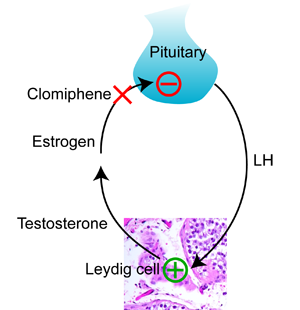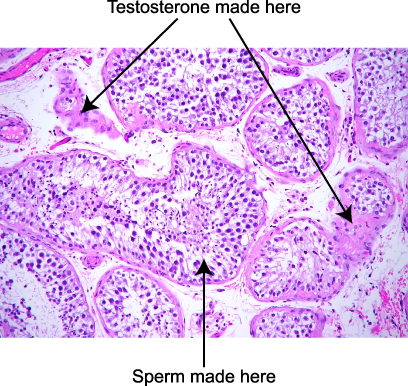September 24th, 2010 § § permalink
I hear that Mel Gibson allegedly blamed what he called depressed and “whacky” behavior on “male menopause.” Putting aside the question of whether he actually wrote the note circulating on the internet, (and that’s a big if,) is there a male menopause? If the answer is yes, can it affect behavior and cause depression?
Testosterone levels do decrease, especially as a man gets older. In one study, testosterone fell on average 110 ng/dL each decade in men over sixty. As the FDA puts the normal line for testosterone in men at 300 ng/dL, that’s a big drop. But it’s happening over ten years.
That’s the essential problem with calling the decline in testosterone as men age “menopause.” The word refers to the rapid plummet of women’s reproductive hormones around age fifty. When a woman’s hormones drop in a short timespan, it’s fairly obvious to her that they’re changing . But male hormones fall more gradually, though the decline is substantial.
Worse, a blood protein called “sex hormone binding globulin,” SHBG for short, is on the rise in the older man. As its name implies, SHBG binds testosterone and renders it useless. The drop in testosterone as men age is magnified by the climb in SHBG.
If testosterone was unnecessary, its decline would go unnoticed, but it’s one of the most important hormones a man has. Low testosterone in older men is associated with muscle wasting, thinning of bones, loss of sex drive, depression and other problems. Testosterone isn’t the only reason for these ailments, but it can be a big part of the puzzle.
If Mel did blame depression on “male menopause,” meaning a low testosterone, it’s possible that the 54 year old actor is feeling a drop in his hormones. If he hasn’t already, he’ll want to get his testosterone checked.
April 28th, 2010 § § permalink
With the suspension of Cincinnati Reds pitcher Edinson Volquez for performance enhancing drug use and a swirl of rumors that the agent involved was clomiphene (also known as Clomid,) I thought it timely to write about how clomiphene works and how it’s used. From what I read on the internets, there is an enormous amount of misinformation floating around out there.
To understand how clomiphene works, you need to know how the pituitary controls the making of testosterone in the testis. Testosterone is made by Leydig cells in the testis, which I explained in my last post. The pituitary releases a hormone called luteinizing hormone (“LH”) that stimulates the Leydig cells to make testosterone. Testosterone is converted to the female hormone estrogen, (which I also explained in my last post,) and estrogen tells the pituitary to stop making more LH. This kind of negative feedback system is common when it comes to how hormones work. It’s just like a thermostat and heater. As the room gets warmer, the thermostat sends less electricity to the heater. When the room gets colder, the thermostat sends more electricity to the heater.
Clomiphene works by blocking estrogen at the pituitary. The pituitary sees less estrogen, and makes more LH. More LH means that the Leydig cells in the testis make more testosterone.
As I explained in my last post, giving testosterone to a man does just the opposite. The pituitary thinks that the testis is making plenty of testosterone, and LH falls. As a result, the testis stops making testosterone, and the usually high levels of testosterone in the testis fall to the lower level in the blood.
So clomiphene is a way to increase testosterone in the blood and the testis at the same time. It preserves testis size and function while increasing blood testosterone.
Unfortunately, clomiphene is not FDA approved for use in the male. Like most of the medications that we use to treat male fertility, the pharmaceutical company that originally sought approval by the FDA did it for women. Clomiphene is now generic, and it’s unlikely that anyone will pony up the hundreds of millions of dollars necessary to get it approved for the male. That’s the bad news. The good news is that it means that this medication is fairly inexpensive, cheaper than most forms of prescription testosterone. Can a doctor prescribe clomiphene for a man? Yes. It’s “off label”, meaning that it’s not FDA approved for use in men.
As a medication, clomiphene is usually well tolerated by men. In my experience, most patients don’t feel anything as their testosterone rises. Those that do feel an increase in energy, sex drive, and muscle mass, especially if they work out. Very rarely I’ve had patients report that they feel too aggressive, or too angry. Very very rarely (twice in the last 20 years) I’ve had patients report visual changes. That’s worrisome, as the pituitary is near the optic nerve in the brain, and visual changes suggests that the pituitary may be changing in size. Because the skull is a closed space, it’s alarming if anything in the brain changes in size. In the last twenty years, I’ve also had two patients who had breast enlargement (called “gynecomastia”) while using clomiphene. Needless to say, for any of these problematic side effects, the clomiphene is discontinued.
So that’s the story with clomiphene. It can be used in the male, either for fertility or low testosterone levels. It’s an off label prescription drug. It works, and is usually well tolerated by men who take it.
April 28th, 2010 § § permalink
When you think of what makes up the inside of the testes, think spaghetti. Imagine a bunch of spaghetti noodles squished together. Inside of the noodles are the developing sperm cells. Between the noodles are cells called “Leydig cells” whose job it is to make the male hormone testosterone. They start with cholesterol, and churn out testosterone.
Not only is testosterone critical to the factory inside the spaghetti that makes sperm, it is important for many parts of the male body to work well. Adequate testosterone is needed for bone and muscle strength, and men with low testosterone may experience low sex drive, problems with mental focus and depression.
The relationship between testosterone and how the penis works is less clear. Men with low testosterone can get erections, but of course sex drive can be a problem. And if a man’s testosterone is low, correcting it may improve the performance of drugs like Viagra, Levitra and Cialis.
Total testosterone doesn’t tell you the whole story. Testosterone circulates in the blood in two forms. Testosterone that is either free or loosely bound to blood protein is called “bioavailable”, and as the name implies, is available for the cells to work. Testosterone that is bound to sex hormone binding globulin (“SHBG”, but also called androgen binding protein,) is blocked from acting in cells. Although many labs offer to measure free testosterone, often the most reliable way to measure bioavailable testosterone is to have the blood tested for albumin, sex hormone binding globulin and testosterone, and then to use a calculator for bioavailable testosterone. One is available on the International Society for the Study of the Aging Male’s web site, and another for iPhones and iPod touches can be found in the iTunes store. A man may have adequate total testosterone, but still suffer from the ravages of low testosterone levels if his bioavailable testosterone is low.
Testosterone levels rise and fall during the day, with a peak in the early morning, and the lowest point in the late afternoon. That’s why many a man’s sex drive is highest in the morning, and it’s time for a nap in the afternoon.
Testosterone is converted to dihydrotestosterone, which makes the hair fall out of your hair follicles if your family tree has male pattern baldness. Dihydrotestosterone also enlarges the prostate. Drugs like finasteride (Propecia and Proscar) and dutasteride (Avodart) block the conversion of testosterone to dihydrotestosterone.
All men have a little estrogen, the female hormone. An enzyme called “aromatase” converts testosterone to estrogen. If the estrogen level is too high, it may interfere with the working of testosterone.
One last important point about the making of testosterone: levels in the testis are twenty times greater than in the blood. So if a man is given testosterone, his blood levels may increase, but the pituitary tells the testis, “hey, there’s enough testosterone around, so stop making it.” As a result, testosterone levels in the testis fall, sperm stop being made, and the testes shrink. That’s why many body builders who take testosterone and other similar chemicals experience shrinking testes. Testosterone can be great for men with low levels later in life, but for men who want to have children, it can really work against sperm production.


